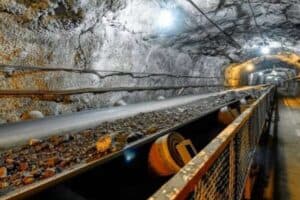Average remuneration has nearly tripled, but jobs are evaporating…

Since the recent peak in 2012, the South African mining industry has been shedding – on average – at least 1 200 jobs per month, every month. Using annual figures from the Chamber of Mines’ Facts and Figures 2016 statistics publication released this month, it seems as if the trend has accelerated. In 2015, 16 700 jobs were lost in the sector (from ±14 500 in both prior years), while in 2016 that number spiked to 21 500.
However, there was improvement during 2016 on the back of better commodity prices. The Chamber says that “whereas 40 000 jobs were lost from the beginning of 2015 (more than 1 500 per month) this slowed at the end of 2016 to around 400 per month”.
| Mining industry direct employment | |
| 2007 | 495 150 |
| 2008 | 518 729 |
| 2009 | 491 794 |
| 2010 | 498 906 |
| 2011 | 512 878 |
| 2012 | 524 632 |
| 2013 | 510 099 |
| 2014 | 495 568 |
| 2015 | 478 868 |
| 2016 | 457 332 |
* Source: Chamber of Mines
In total, however, 67 300 jobs have been lost in the sector since 2012. When measured by commodity, these declines have largely been across the board.
| Gold | PGMs | Iron Ore | Copper | Chrome | Manganese | Diamonds | Coal | |
| 2007 | 166 064 | 186 410 | 13 857 | 4 241 | 9 796 | 3 239 | 19 471 | 60 439 |
| 2008 | 166 423 | 199 948 | 13 257 | 3 523 | 12 279 | 3 976 | 18 474 | 65 484 |
| 2009 | 159 926 | 184 162 | 13 728 | 3 366 | 10 966 | 5 003 | 11 601 | 70 791 |
| 2010 | 157 019 | 181 969 | 18 216 | 3 032 | 13 982 | 5 879 | 11 467 | 74 025 |
| 2011 | 144 799 | 194 745 | 22 360 | 3 237 | 16 911 | 7 460 | 12 047 | 78 580 |
| 2012 | 142 200 | 197 752 | 23 380 | 2 533 | 19 762 | 8 685 | 12 332 | 83 244 |
| 2013 | 131 738 | 191 260 | 21 127 | 2 930 | 18 358 | 9 842 | 13 579 | 88 039 |
| 2014 | 119 007 | 186 864 | 21 794 | 2 853 | 18 658 | 9 971 | 15 356 | 86 106 |
| 2015 | 115 055 | 187 756 | 20 760 | 2 805 | 18 470 | 8 657 | 17 481 | 77 773 |
| 2016 | 116 479 | 172 444 | 16 490 | 2 366 | 15 514 | 7 240 | 17 978 | 77 506 |
Employment in the gold and PGMs sectors make up nearly two thirds of total mining employment. The problem, of course, is that South African gold mining is in long-term structural decline. Barring the 1 500-odd jobs added between 2015 and last year, the numbers have been in freefall, along with production. A decade ago, with 166 064 employees, South Africa produced 10.1% (252.6 tons) of total global output. In 2016, that had dropped by 44% to just 4.4% (142.1 tons) of world gold production, which continues to decrease.
But, total employee earnings in the sector roughly doubled from R14.7 billion in 2007 to R28.5 billion in 2016. This means that the average annual remuneration per mineworker in the gold sector has nearly tripled over the decade from R87 354 to R246 665. Put another way, average pay has gone from R7 280 per month to R20 555. Mike Schüssler argued this point on Moneyweb in August last year: Some minimum salaries are higher than you think.
There have been similar increases in the PGMs sector. The average annual remuneration per mineworker has gone from R98 391 in 2007 to R266 036 last year. Average monthly pay is R22 170 (from R8 199). The Chamber says that employee earnings in this sector increased by an average of 16.4% per year between 2005 and 2016.
Across mining as a whole, the average annual remuneration per mineworker increased from R101 043 in 2007 to R262 553 in 2016.
Of course, these are averages, not the median. Using data from StatsSA, the Chamber notes that “between 2010 and 2015, employees in the mining and utilities industries were the top performing earners, with the largest nominal increases in earnings also recorded for these two sectors (R2 500 and R1 500 respectively)”.
| Median monthly earnings of employees, by industry | ||
| 2010 | 2015 | |
| Agriculture | R1 295 | R2 231 |
| Mining | R5 000 | R7 500 |
| Manufacturing | R3 250 | R3 800 |
| Utilities | R6 000 | R7 500 |
| Construction | R2 437 | R3 000 |
| Trade | R2 505 | R3 100 |
| Transport | R3 500 | R4 000 |
| Finance | R3 501 | R4 000 |
| Services | R6 000 | R5 000 |
| Private households | R1 000 | R1 500 |
| Total | R2 900 | R3 100 |
The mining industry is very well paid, in comparison to others. But (and this is the big worry): we’re producing and exporting more (certainly in rand terms), but with fewer people.
In real terms, mining was 7.3% of total GDP in 2016, below the 8% average over the last decade. Primary mineral exports as a percentage of the total was at 21% in 2016, and as a percentage of merchandise exports, it was 28%. Both of these are below the averages over the past decade, of 23.8% and 32%, respectively.
When it comes to fixed investment, the picture is even scarier. The year-on-year growth rate declined by 1% in 2015 and 3.8% in 2016. But, in the absence of other meaningful increases in fixed investment elsewhere in the economy, mining’s contribution to gross fixed capital formation is at 18%, the highest it’s been since 2009-2011.
The Chamber cautions that “although gross fixed investment has declined by only about 1% on average since 2013, the fact that the sector is really in survival mode is reflected in a progressively worsening net investment trend: -2.5% in 2013, -0.4% in 2014, -10.5% in 2015 and a more than 100% contraction in 2016”.
Brought to you by Moneyweb








